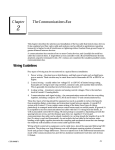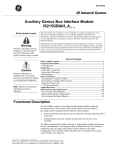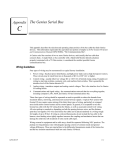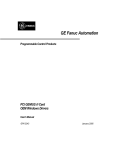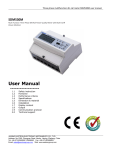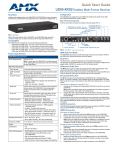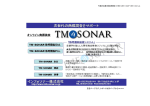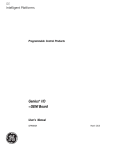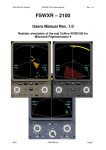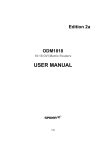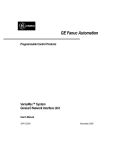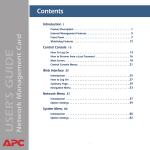Download PCI Genius Card IC660ELB931 Quick Install, GFK-2342
Transcript
PCI Genius® Card Quick Install Guide PCI Genius Card IC660ELB931 October 2004 ________________________________________ GFK-2342 GFL-002 Warnings, Cautions, and Notes as Used in this Publication Warning Warning notices are used in this publication to emphasize that hazardous voltages, currents, temperatures, or other conditions that could cause personal injury exist in this equipment or may be associated with its use. In situations where inattention could cause either personal injury or damage to equipment, a Warning notice is used. Caution Caution notices are used where equipment might be damaged if care is not taken. Note: Notes merely call attention to information that is especially significant to understanding and operating the equipment. This document is based on information available at the time of its publication. While efforts have been made to be accurate, the information contained herein does not purport to cover all details or variations in hardware or software, nor to provide for every possible contingency in connection with installation, operation, or maintenance. Features may be described herein that are not present in all hardware and software systems. GE Fanuc Automation assumes no obligation of notice to holders of this document with respect to changes subsequently made. GE Fanuc Automation makes no representation or warranty, expressed, implied, or statutory with respect to, and assumes no responsibility for the accuracy, completeness, sufficiency, or usefulness of the information contained herein. No warranties of merchantability or fitness for purpose shall apply. Any trademarks referenced herein are used solely for purposes of identifying compatibility with the products of GE Fanuc Automation. ©Copyright 2004 GE Fanuc Automation North America, Inc. All Rights Reserved. The PCI Genius Card has been tested and found to meet or exceed the requirements of U.S. (47 CFR 15), Canadian (ICES-003), Australian (AS/NZS 3548) and European (EN55022) regulations for Class A digital devices when installed in accordance with guidelines noted in this manual. Note: This device complies with Part 15 of the FCC rules. Operation is subject to the following two conditions: (1) This device may not cause harmful interference, and (2) This device must accept any interference received including interference that may cause undesired operation. Note: This Class A digital apparatus complies with Canadian ICES-003. Note: This equipment has been tested and found to comply with the limits for a Class A digital device, pursuant to Part 15 of the FCC Rules. These limits are designed to provide reasonable protection against harmful interference when the equipment is operated in a commercial environment. This equipment generates, uses, and can radiate radio frequency energy and, if not installed and used in accordance with the instruction manual, may cause harmful interference to radio communications. Operation of this equipment in a residential area is likely to cause harmful interference in which case the user will be required to correct the interference at his own expense. Note: Any changes or modifications to the product or installation that are not expressly approved by GE Fanuc Automation could void the user's authority to operate the equipment under FCC rules. The following statements are required to appear for Class 1, Div 2 Hazardous Locations. 1. EQUIPMENT LABELED WITH REFERENCE TO CLASS 1, GROUPS A, B, C, AND D, DIV 2 HAZARDOUS LOCATIONS IS SUITABLE FOR USE IN CLASS 1, DIVISION 2, GROUPS A, B, C, D, OR NON-HAZARDOUS LOCATIONS ONLY. 2. WARNING - EXPLOSION HAZARD - SUBSTITUTION OF COMPONENTS MAY IMPAIR SUITABILITY FOR CLASS 1, DIVISION 2. 3. WARNING - EXPLOSION HAZARD - DO NOT DISCONNECT EQUIPMENT UNLESS POWER HAS BEEN SWITCHED OFF OR THE AREA IS KNOWN TO BE NONHAZARDOUS. 4. WARNING - EXPLOSION HAZARD - WHEN IN HAZARDOUS LOCATIONS, TURN OFF POWER BEFORE REPLACING OR WIRING MODULES Table of Contents Table of Contents.................................................................. 5 Description ............................................................................ 7 PCI Genius Card ...........................................................................7 Faceplate ......................................................................................7 Software ........................................................................................8 Programming Interface..................................................................8 Installing the PCI Genius Card ............................................ 9 Mechanical Overview............................................................ 9 Indicators ............................................................................. 11 Connecting the Bus ............................................................ 13 Sample Bus Configuration ................................................. 13 DIP Switch Setting .............................................................. 15 Bus Termination Resistor Setting................................................15 Specifications...................................................................... 17 Board Specifications....................................................................17 Network Specification..................................................................18 Bus Cable Type and Maximum Cable Length: ............................18 Product Certification ....................................................................21 Diagnostics .......................................................................... 22 Diagnostic Steps .........................................................................22 Appendix A .......................................................................... 25 History .........................................................................................25 PCI Genius Card GFK-2342 PCI Configuration........................................................................26 Functional Registers....................................................................27 Shared RAM Memory Map..........................................................35 PCI Genius Card GFK-2342 7 Description PCI Genius Card The PCI Genius card provides an intelligent interface between a PCI slot in a PC compatible computer and a single channel general purpose controller interface to the Genius serial bus. This card complies with Rev 2.2 of PCI Local Bus Specification and handles all the interface and protocol tasks associated with the Genius bus communications. The primary function of this card is to provide a means for third parties to interface the CPU, PLC, or Genius I/O Blocks on the Genius bus. Faceplate The PCI Genius card has a 4-pin right angle male terminal box connector with retention screws for the Genius I/O interface. Two LEDs (GENI OK and COMM OK) on the faceplate indicate the single channel Genius bus status. Openings in the faceplate accommodate the bus connector and LEDs. PCI Genius Card GFK-2342 8 Software If you are using the PCI Genius card with Machine Edition software, Machine Edition installs custom drivers for its use. Please consult the topic "Installing the device driver for a PCI device (card)" in the Machine Edition online help for more details. If you are not using Machine Edition, you can use a Windows driver for the PCI Genius card that is available for Windows NT4, 2000, and XP. This driver allows user-mode programs to gain access to the PCI Genius card’s Shared RAM, configuration register, status register, and control register and also to determine the physical bus and slot of the card. The driver is available under special license from GE Fanuc. Contact the GE Fanuc Global Customer Care Center at 1-800-GEFANUC for more details concerning part number 44A750896-G01. Programming Interface Programming user applications to communicate with the drivers are not covered in this manual. Users wishing to write their own interface to the hardware should see Appendix A for hardware register details. PCI Genius Card GFK-2342 9 Installing the PCI Genius Card Warning: Always use anti-static precautions when handling the PCI Genius card or working inside the host computer. 1. Power off the host computer and unplug it from its power source. 2. Install the PCI Genius card according to computer manufacturer's instructions for option cards. 3. Power up the computer and login to Windows. Mechanical Overview The PCI Genius card is shown on the next page. The interface card will plug into PCI slot of a computer. The Genius bus connector is where the Genius bus cable is connected to the module. DIP switches are used to set the termination resistance for the Genius bus. LED indicators display the status of the module. PCI Genius Card GFK-2342 10 PCI Genius Card GFK-2342 11 Indicators The Genius Interface module has two LED indicators on the faceplate. These are used for displaying the status of the module. PCI Genius Card GFK-2342 12 LED Communication OK Genius OK PCI Genius Card LED Status Description ON The Genius Interface can send and receive data on the serial bus. OFF (Flashing) An error has been detected in communications on the serial bus. ON Power is available to the Genius Interface, and the onboard self-diagnostics passed. OFF The watchdog timer has timed out, indicating a board failure. GFK-2342 13 Connecting the Bus Devices can be connected in any physical sequence on the bus. The Genius bus connector has four terminals for the bus cable: (Serial 1 (X1), Serial 2 (X2), Shield In (SI), and Shield Out (SO)). Connect the Serial 1 terminal of each connector to the Serial 1 terminals of the previous device and the next device. Connect the Serial 2 terminal of each connector to the Serial 2 terminals of the previous device and the next device. Shield In of each connector must be connected to Shield Out of the preceding device. For the first device on the bus, Shield In can be left unconnected. For the last device on the bus, Shield Out can be left unconnected. Sample Bus Configuration Terminating Resistor Start of Bus PCI Genius Card End of Bus Terminating Resistor GFK-2342 14 Caution: When making bus connections, the maximum exposed length of bare wires should be two inches. For added protection, each shield drain wire should be insulated with electrically isolated tubing to prevent the Shield In and Shield Out wires from touching each other. Refer to The Genius I/O System and Communications User’s Manual, GEK-90486-1 for additional details on Genius bus wiring. PCI Genius Card GFK-2342 15 DIP Switch Setting Bus Termination Resistor Setting A bus must be terminated at each end by the correct impedance for the particular cable type. The impedance will be either 75, 100, 120, or 150 ohms. Install the appropriate terminating resistor across the Serial 1 and Serial 2 terminals. The Genius Interface has on-board termination resistors that can be selected by the DIP switch setting. The Genius I/O System and Communications User’s Manual, GEK-90486-1 lists appropriate terminating resistors for each recommended bus cable type. The DIP switch configuration should be set according to the description on the next page. PCI Genius Card GFK-2342 16 ON 1 2 3 4 Pole1 Pole 2 Pole3 Pole 4 Resistor Value ON OFF OFF OFF 150 OHM ON ON OFF OFF 125 OHM 100 OHM ON ON ON OFF ON ON ON ON 75 OHM OFF OFF OFF OFF *NONE * Default setting. PCI Genius Card GFK-2342 17 Specifications Board Specifications Environmental: Operating: Operating temperature at board Humidity Vibration Shock Non–operating: Ambient Temperature at board Humidity Vibration Shock PCI Genius Card 0°C to +60°C, 32°F to + 140°F 5% to 95% non–condensing IEC 68-2-6; 10 - 57Hz, 0.012" peak to peak displacement; 57 - 500Hz, 1.0g constant acceleration. IEC 68-2-27; 15g, 11ms (sine wave). –40°C to +85°C, –40°F to +185°F 5% to 95% non–condensing IEC 68-2-6; 10 - 57Hz, 0.012" peak to peak displacement; 57 - 500Hz, 1.0g constant acceleration IEC 68-2-27; 15g, 11ms (sine wave). GFK-2342 18 Network Specification Bus Type Daisy-chained bus cable; single twisted pair plus shield or Twinax Bus Termination On board DIP switch selectable: None, 75, 100, 120, or 150 ohms. Baud Rate Configurable 153.6 Kbaud standard, 153.6 Kbaud extended, 76.8 Kbaud, or 38.4 Kbaud. Max. Number of Devices 32 devices at 153.6 Kbaud standard, 153.6 Kbaud extended, or 76.8 Kbaud. 16 devices at 38.4 Kbaud. Bus Cable Type and Maximum Cable Length: Cable # & Make Terminating Resistor –10%to+20% 1/2 Watt Maximum Length Cable Run, feet/meters at baud rate 153.6s 153.6e 76.8 38.4 • (A)9823 (B)9182 (C)4596 (M)M39240 150 ohms 2000ft 606m 3500ft 1061m 4500ft 1364m 7500ft 2283m (B)89182 150 ohms 2000ft 3500ft 4500ft 7500ft PCI Genius Card GFK-2342 19 Cable # & Make Terminating Resistor –10%to+20% 1/2 Watt Maximum Length Cable Run, feet/meters at baud rate 153.6s 153.6e 76.8 38.4 • 606m 1061m 1364m 2283m (B)9841 (M)M3993 120 ohms 1000ft 303m 1500ft 455m 2500ft 758m 3500ft 1061m (A)9818C (B)9207 (M)M4270 100 ohms 1500ft 1818m 2500ft 455m 3500ft 758m 6000ft 1061m (A)9109 (B)89207 (C)4798 (M)M44270 100 ohms 1500ft 1818m 2500ft 455m 3500ft 758m 6000ft 1061m (A)9818D (B)9815 100 ohms 1500ft 1818m 2500ft 455m 3500ft 758m 6000ft 1061m (A)9818 (B)9855 (M)M4230 100 ohms 1200ft 364m 1700ft 516m 3000ft 909m 4500ft 1364m (A)9110 (B)89696 100 ohms 1200ft 364m 1700ft 516m 3000ft 909m 4500ft 1364m PCI Genius Card GFK-2342 20 Cable # & Make Terminating Resistor –10%to+20% 1/2 Watt Maximum Length Cable Run, feet/meters at baud rate 153.6s 153.6e 76.8 38.4 • (B)89855 (M)M64230 (A)9814C) (B)9463 (M)M4154 75 ohms 800ft 242m 1500ft 455m 2500ft 758m 3500ft 1061m (A)5902C (B)9302 (M)M17002 75 ohms 800ft 242m 1500ft 455m 2500ft 758m 3500ft 1061m Notes: A = Alpha, B = Belden, C = Consolidated, M = Manhattan • = Limited to 16 taps at 38.4 Kbaud Refer to The Genius I/O System and Communications User’s Manual, GEK-90486-1 for details on selection and installation of the bus cable. PCI Genius Card GFK-2342 21 Product Certification Description Agency Standard or Marking Comments North American Safety for Industrial Control Equipment UL 508/C-UL Certification by Underwriter’s Laboratories to UL standard and equivalent CSA standard North American Safety for Hazardous Locations Class I, Div. 2, Groups A, B, C, D UL 1604C-UL Certification by Underwriter’s Laboratories to UL standard and equivalent CSA standard Electromagnetic Compatibility Directive European EMC for Industrial Control Equipment CE Certification by Competent Body in accordance with European Directives. Refer to Declaration of Conformity. PCI Genius Card GFK-2342 22 Diagnostics Troubleshooting involves thinking logically of the function of each part of the system, and understanding how these functions interrelate. When problems occur, the total system must be considered. All the devices on the bus must be connected and operating properly. A malfunction causing improper operation of Genius Interface board can usually be isolated by checking the board LEDs on the module. These indicate the status of the board itself and its communications with the Genius bus. During proper operation, both the LEDs will be on. Diagnostic Steps The module should be plugged in, powered up and the proper software application should be running: Indication Genius OK is off COMM OK is on PCI Genius Card Troubleshooting Steps Make sure the correct parameters are entered using the configuration software. Ensure that the Genius interface Module is completely inserted in the host backplane connector, and that all connector pins are properly aligned. If these steps do not correct the problem, replace the Genius Interface Module. GFK-2342 23 Indication Troubleshooting Steps Genius OK is on COMM OK is off Ensure correct cable type and length (see Genius I/O System and communications User’s Manual, GEK-904861). Ensure correct terminating resistors are installed at both ends of the bus length (see Genius I/O System and communications User’s Manual, GEK-90486-1). Ensure the serial bus is wired in a daisy-chain fashion. Make sure cabling is not in proximity to high voltage runs. Make sure cable is not broken. Both LEDs are off Make sure the Genius interface Module is plugged in, seated properly, and receiving power. Make sure the proper software application is loaded and running. (Try reloading the application) Both LEDS are flashing together PCI Genius Card Two devices on the same bus have probably been configured with the same Device Number (serial bus address). Check the bus addresses, and if necessary correct them. GFK-2342 24 Indication Troubleshooting Steps Repeated bus errors occur Ensure that cable shielding is properly installed and Grounded (see Genius I/O System and communications User’s Manual, GEK-90486-1). Unplug the bus communications cable from the Interface Module, verify the serial bus addresses (SBAs) of all network nodes with a hand-held monitor (HHM), and use the HHM to read the configuration and verify device numbers and I/O reference numbers. Bus errors--can’t get the Interface Module up and running Serial 1 and Serial 2 are crossed. Correct the bus wiring (see “Sample Bus Configuration” on page 14.) Intermittent or total lack of communications Mixed baud rates. Power up blocks one at a time and confirm the baud rate for each. Any changes to baud rate in a block will not take effect until block power is cycled. PCI Genius Card GFK-2342 25 Appendix A Many users of the ISA bus Genius cards have developed private software that interfaces with the Genius network. This appendix provides hardware details to help those users transition to the PCI card. History In working with the GENIUS PCI card, it is helpful to understand some of the history of the GENIUS PC interfaces. The core of the GENIUS PC interface products is a shared memory module called a GENI or µGENI, which is described in the Genius I/O µGENI Board User’s Manual, GFK-0845. This module has a 16Kbyte memory mapped interface that allows a host processor to communicate on the GENIUS network. The other input and output signals to a µGENI module are the four GENIUS bus lines, two LED signals, and eight initialization signals that specify the card's SBA, network baud rate, and output enabled status. Previous ISA PC GENIUS cards either implemented the µGENI circuitry as a single circuit board or had a carrier ISA circuit board that allowed one or two µGENI daughter modules to attach to the carrier ISA circuit board. The eight initialization signal values and the address information as to where the µGENI mapped into the ISA space were programmed into non-volatile memory on the carrier board. This configuration information resided at one range of I/O registers and control of the reset PCI Genius Card GFK-2342 26 and watchdog lines going into the µGENI hardware were controlled at a second set of I/O registers. The GENIUS PCI card continues this tradition. The µGENI module has been integrated onto the single circuit board and the setup signals and control of the reset and watchdog functions have been mapped to I/O registers. There is no non-volatile memory on the PCI card, so the card does not retain its SBA address, bus baud rate, or output enable state in non-volatile storage. PCI Configuration The Device and Vendor IDs of the PCI Genius card are 0x0100 and 0x1FC3. The card reports five resource descriptors: - An interrupt descriptor - A four byte I/O area for the Functional Registers A memory and I/O region of length 128 bytes for access to the internal PCI hardware A 16K byte memory area for the Shared RAM Users programming their own drivers should only need to access the Functional Registers and Shared RAM in most cases. PCI Genius Card GFK-2342 27 Functional Registers The PCI Genius card has three I/O mapped registers. The PCI stack maps these registers into I/O space The Windows driver controls access to these registers. Register Size Description Access Type 0 1 Byte Configuration Register Read /Write 1 1 Byte Status Register Read only 2 1 Byte Control Register Read /Write PCI Genius Card GFK-2342 28 Configuration Register The Configuration register must be programmed prior to releasing the PCI Genius card from reset. The bits of this register are read by the µGENI firmware during its initialization. The bits of this register are described below: Bit Name Function 7 Output Enable 0=enabled 1=disabled (Default) 6—5 Baud Rate Serial Bus Baud Rate 00=153.6 Kbaud Extended (8 bit skip time) 01=38.4 Kbaud (8 bit skip time) 10=76.8 Kbaud (8 bit skip time) 11=153.6 Kbaud Standard (4 bit skip time) (Default) 4—0 Address Serial Bus Address, see “Serial Bus Addresses” on page 29. PCI Genius Card GFK-2342 29 Serial Bus Addresses Default PCI Genius Card Bit4 Bit3 Bit2 Bit1 Bit0 SBA 0 0 0 0 0 0 0 0 0 0 1 1 0 0 0 1 0 2 0 0 0 1 1 3 0 0 1 0 0 4 0 0 1 0 1 5 0 0 1 1 0 6 0 0 1 1 1 7 0 1 0 0 0 8 0 1 0 0 1 9 0 1 0 1 0 10 0 1 0 1 1 11 0 1 1 0 0 12 0 1 1 0 1 13 0 1 1 1 0 14 0 1 1 1 1 15 1 0 0 0 0 16 GFK-2342 30 PCI Genius Card Bit4 Bit3 Bit2 Bit1 Bit0 SBA 1 0 0 0 1 17 1 0 0 1 0 18 1 0 0 1 1 19 1 0 1 0 0 20 1 0 1 0 1 21 1 0 1 1 0 22 1 0 1 1 1 23 1 1 0 0 0 24 1 1 0 0 1 25 1 1 0 1 0 26 1 1 0 1 1 27 1 1 1 0 0 28 1 1 1 0 1 29 1 1 1 1 0 30 1 1 1 1 1 31 GFK-2342 31 Status Register The individual bits in the Status register have the following functions: 7 6 5 4 3 2 1 0 GENI Reset Detect Watchdog Timer Status GENI OK COMM OK Bit 0 –GENI RESET Detect This bit is set to 0 whenever PCI Genius board goes into reset. During normal operation this bit will be 1. Bit 1 – Watchdog Timer Status This bit is 1 if the watchdog timer is being pulsed every 500ms. The watchdog timer is pulsed by the accesses into the Shared Memory area. If the timer expires, this bit goes to 0. The Shared RAM area should be accesses to set this value before enabling the watchdog timer. PCI Genius Card GFK-2342 32 Bit 3 –GENI OK The state of this bit follows the condition of the GENI OK LED on the board. If the LED is lit, the GENI OK bit is 0. This bit also indicates the MIT watchdog timer (an onboard firmware watchdog timer) has timed out, indicating a failure in the onboard firmware. The board can be reset by pulsing bit 6 of the control register to low and then high again. Bit 4 – COMM (Communications) OK Like the GENI OK bit, this bit follows the output of one of the LED’s on the board. This bit is 0 if the COMM OK LED on the board is lit. PCI Genius Card GFK-2342 33 Control Register The individual bits in the Control register are used for the following functions: 7 6 5 4 3 2 1 0 HHM Present Test WDT Enable Board Reset Bit 3 – HHM Test An HHM present can be indicated even when one is not plugged in by raising this bit to 1. After power up and under normal conditions, this bit should be 0. It is not used on the PCI Genius card. Bit 5 – WDT Enable When this bit is 0 it enables the hardware watchdog timer. The host can set this bit to '1' to disable the watchdog timer. During power on this bit will be default zero (watchdog timer enabled). Bit 6 –Board RESET When this bit is 0 it resets the PCI Genius board. Under normal running conditions, it should be 1. During power on, this bit will default to 0. Before setting this bit to 1, the host can update the configuration register PCI Genius Card GFK-2342 34 and the control register; this bit can be set to 1 to bring the board out of reset. Watchdog Timer The watchdog timer provides watchdog time out period of 0.99 seconds. Once the watchdog circuit is enabled, it will monitor access to the Shared RAM area of the card. If the host does not access the card within the 0.99 seconds +/- 25% the watchdog expires. It is recommended that host application should communicate with the Genius card at least once every 0.5 second. The host should access the Shared RAM area at least one before enabling the watchdog to reset the timeout before enabling the watchdog reset feature. PCI Genius Card GFK-2342 35 Shared RAM Memory Map The 16Kbyte Shared RAM area is allocated by the PCI stack. User applications must use a Windows driver to access this area or map it to the process address space. Host Address Content Base + 0x0000 Request Queue Size in bytes 2176 Base + 0x0880 Request Queue Head Pointer 1 Base + 0x0881 Request Queue Tail Pointer 1 Base + 0x0882 Setup Table 16 Base + 0x0892 Status Table 16 Base + 0x08A2 Interrupt Status Table 16 Base + 0x08B2 Interrupt Disable Table 16 Base + 0x08C2 Command Block 16 Base + 0x08D2 Transmit Datagram Buffer 240 Base + 0x09C2 Read Datagram Buffer 134 Base + 0x0A48 I/O Table lockout Request 1 Base + 0x0A49 I/O Table lockout state 1 Base + 0x0A4A Host Clear 1 Base + 0x0A4B Reserved 64 PCI Genius Card GFK-2342 36 Host Address Content Size in bytes Base + 0x0A8B Auxiliary Request Queue 48 Base + 0x0ABB Heartbeat Enable 2 Base + 0x0ABD Heartbeat Timeout Multiplier 1 Base + 0x0ABF Reserved 4930 Base + 0x1E00 Device Configuration Table 256 Base + 0x1F00 Directed Control Input Table 128 Base + 0x1F80 Broadcast Control Output Table 128 Base + 0x2000-0x3FFF Device I/O Table 8192 For more details on how to operate the Shared RAM Interface refer to the Genius I/O µGENI Board User’s Manual, GFK-0845. PCI Genius Card GFK-2342




































